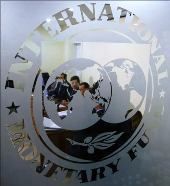 | « Back to article | Print this article |
 As India graduates to a middle-income country and becomes ineligible for soft loans from World Bank, the government is working out a transitional arrangement with the multilateral institution till 2021.
As India graduates to a middle-income country and becomes ineligible for soft loans from World Bank, the government is working out a transitional arrangement with the multilateral institution till 2021.
The World Bank would provide loans to India at higher than its existing concessional rates but lower than the market rate.
The funds would come as a shot in the arm at a time when the government is battling with a problem of high current account deficit and dwindling capital flows and slow economic growth lead to lack of funding for its social and infrastructure projects.
The multilateral institution lends to countries under its two arms -- the International Development Association and International Bank for Reconstruction and Development.
The former, which provides concessional or interest-free loans, is primarily meant for low income economies, while the latter provides longer maturity loans at a higher rate for middle-income economies.
Loans to some countries are a blend of both IDA and IBRD, and India is one of these.
With India’s per capita gross domestic product taking it into the lower middle-income category, the World Bank wanted to stop lending through IDA and switch over to IBRD.
IDA funds are used largely in social sector projects, while IBRD is primarily for infrastructure projects.
These work out to be cheaper than external commercial borrowings.
“We are entering into a transitional arrangement with the World Bank for providing concessional loans for another seven years.
“The new rate would be somewhere between the IDA and IBRD,” a government official, who did not wish to be identified, told Business Standard.
Making a case for continuing the loan pipeline at lower rates, the Indian government has told the World Bank that India is still a country of poor people, with 23 per cent of its population or 269.7 million people below the poverty line.
According to World Bank estimates, nearly a third of the world’s poor live in India.
At a time when interest rates are hardening, India might lose over $2 billion of low-cost funds if the IDA pulls out.
The World Bank provides IDA funding to 64 countries and IBRD to 62 countries.
As many as 18 countries get loans under the blend category (both IDA and IBRD), including Armenia, Georgia, Grenada, Mongolia, Pakistan, Papua New Guinea, Sri Lanka Uzbekistan, Vietnam, Zimbabwe and Bosnia & Herzegovina.
A total of 80 countries are currently eligible to receive IDA resources.
Together, these countries are home to 2.5 billion people, half of the population of the developing world.
An estimated 1.8 billion people there survive on incomes of $2 or less a day, according to the World Bank.
Economies with a per capita income of $1,035 are defined as lower income by the World Bank.
Those between $1,035 and $4,085 are in the lower-middle-income category.
India’s per capital income was $1,265.77 in 2012-13 (Rs stood at 54.33 against a dollar on an average that year).
Since 1949, when India took the first assistance from the World Bank, the bank's cumulative commitment to India stands at $ 91.91 billion ($48.28 billion under IBRD and $43.63 billion under IDA up to July 2012).
India has been borrowing from the World Bank for various development projects in areas of poverty alleviation, infrastructure, rural development, and human resource development.
LOAN BOOK
Current terms and conditions of World Bank lending to India
IBRD loans (flexible loans): With variable spread option
IBRD IFL allows borrowers to customise the repayment terms (i.e. grace period, repayment period and amortisation profile)
IDA Credits: From July 1, 2011
Source: Ministry of Finance